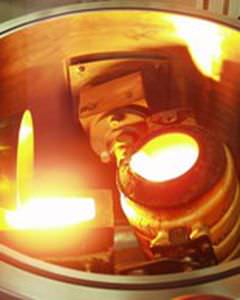
- Products
- Catalogs
- News & Trends
- Exhibitions
Heat treatment furnace COVsinteringbrazingrotary retort



Add to favorites
Compare this product
Characteristics
- Function
- heat treatment, sintering, brazing
- Configuration
- rotary retort
- Heat source
- gas
- Atmosphere
- vacuum
- Maximum temperature
Min.: 0 °C
(32 °F)Max.: 2,200 °C
(3,992 °F)- Capacity
4.5 l, 9.5 l, 180 l, 2,250 l, 4,400 l
(1.19 gal, 2.51 gal, 47.55 gal, 594.39 gal, 1,162.36 gal)
Description
COV heat treatment furnaces are high performance most efficient furnaces with a wide working-temperature and application range. Due to the compatibility with all kind of process gases and the fully automatic process runs they are especially suitable for the economic application in industrial productions for example to produce hard metals or for the cleaning and purification of graphite parts and components.
Applications:
operating temperatures up to 1.100 °C: heat treatment, brazing, reduction, degassing and debinding
operating temperatures up to 1.350 °C: heat treatment, brazing, degassing, debinding and sintering
operating temperatures up to 1.600 °C: debinding and sintering of hard metals
operating temperatures up to 1.800 °C: sintering of non-oxydic ceramics
operating temperatures up to 2.000°C: CVD- and pyrolytic processes, degassing and cleaning, sintering
operating temperatures up to 2.200 °C: CVD-processes, degassing and cleaning
Depending on the process requirements furnaces with operating temperatures up to 3.000 °C are available.
Reduction and degassing of water atomized metal powders (1.100 °C)
Powder production by nitriding (Si3N4) or carburizing (refractory metal carbides) (1.400 - 2.000 °C)
CVD-processes, e.g. coating of graphite parts with SiC (1.800 °C)
Cleaning of graphite under reactive gases (2.200 °C)
Pressure-less sintering of non-oxydic ceramics as e.g. Si3N4 and SiC (1.500 - 1.900 °C)
Related Searches
- Furnace
- Chamber furnace
- Electric furnace
- Heat treatment furnace
- Drying furnace
- Combustion furnace
- Gas furnace
- Controlled atmosphere furnace
- Industrial furnace
- Vacuum furnace
- Melting furnace
- Sintering furnace
- Induction furnace
- Bell furnace
- Brazing furnace
- Hydrogen furnace
- Pressure furnace
- Analysis furnace
- Rotary retort furnace
- Ingot furnace
*Prices are pre-tax. They exclude delivery charges and customs duties and do not include additional charges for installation or activation options. Prices are indicative only and may vary by country, with changes to the cost of raw materials and exchange rates.







